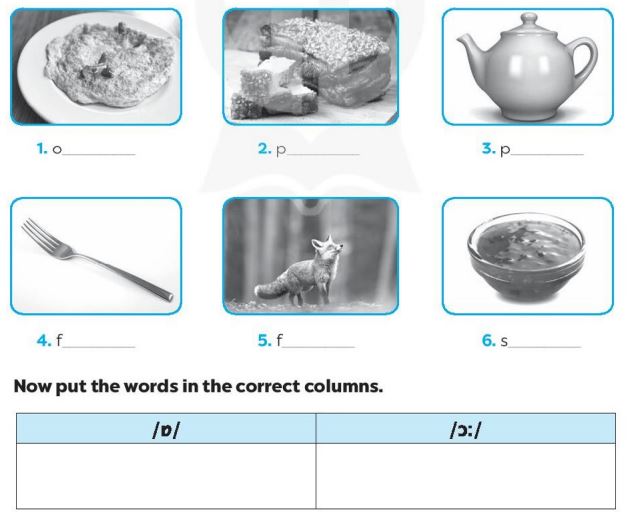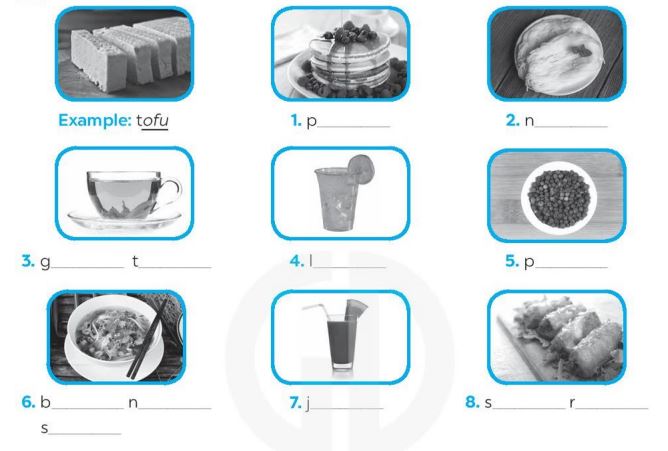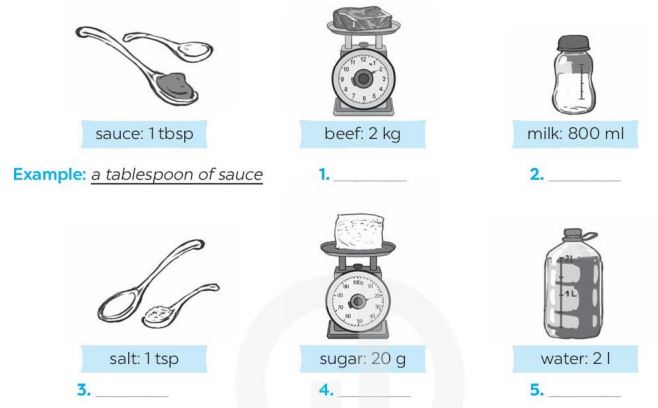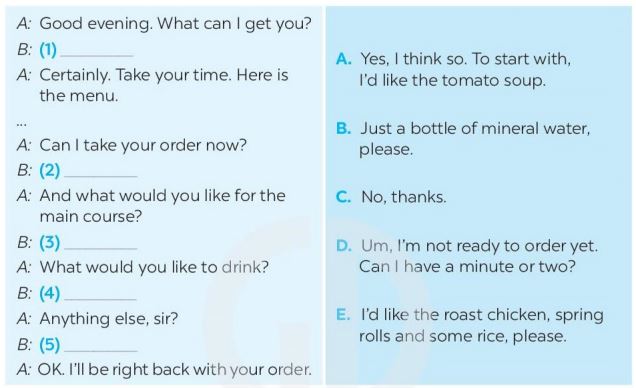Hướng dẫn Giải bài tập Unit 5 lớp 7 Kết nối tri thức Looking Back - Luyện tập môn Tiếng Anh lớp 7 Kết nối tri thức giúp các em học sinh nắm vững phương pháp giải bài tập và ôn luyện tốt kiến thức.
-
Sách bài tập Tiếng Anh 7 trang 35 Unit 5 Pronunciation Kết nối tri thức Exercise 1
Find the word which is pronounced differently in the part underlined.
(Tìm các từ có phần gạch chân phát âm khác với các từ còn lại.)
1.
A. pan
B. ham
C. lamb
D. plate
2.
A. pot
B. bottle
C. roll
D. hot
3.
A. daughter
B. sauce
C. fault
D. laugh
4.
A. was
B. walk
C. water
D. wall
5.
A. morning
B. forget
C. pork
D. fork
-
Sách bài tập Tiếng Anh 7 trang 35 Unit 5 Pronunciation Kết nối tri thức Exercise 2
Give the names of the following pictures. Then read the words aloud. (The first letter of each word is given.).
(Điền tên vào các hình sau. Sau đó đọc to các từ. (Chữ cái đầu tiên của mỗi từ được cho sẵn.).)
-
Sách bài tập Tiếng Anh 7 trang 36 Unit 5 Vocabulary & Grammar Kết nối tri thức Exercise 1
Write the words or phrases with the given letters under the pictures.
(Viết các từ hoặc cụm từ với các chữ cái đã cho dưới các bức ảnh.)
-
Sách bài tập Tiếng Anh 7 trang 36 Unit 5 Vocabulary & Grammar Kết nối tri thức Exercise 2
Do the puzzle. Find the food in the blue column.
(Giải câu đố. Tìm tên món ăn ở cột màu xanh.)
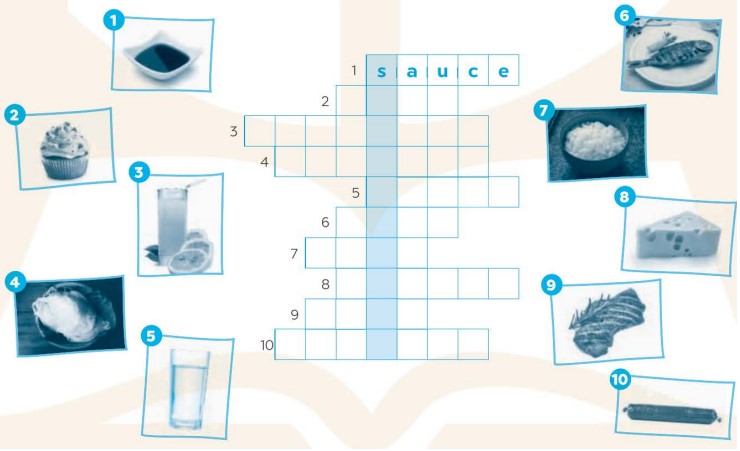
-
Sách bài tập Tiếng Anh 7 trang 37 Unit 5 Vocabulary & Grammar Kết nối tri thức Exercise 3
Write the amount under each picture.
(Viết số lượng dưới mỗi bức ảnh.)
-
Sách bài tập Tiếng Anh 7 trang 37 Unit 5 Vocabulary & Grammar Kết nối tri thức Exercise 4
Match the phrase in column A with the nouns in column B.
(Nối các cụm từ ở cột A với các danh từ ở cột B.)
-
Sách bài tập Tiếng Anh 7 trang 37 Unit 5 Vocabulary & Grammar Kết nối tri thức Exercise 5
Choose the correct words or phrases to complete the sentences below.
(Chọn các từ hoặc các cụm từ đúng để hoàn thành các câu dưới đây.)
1. I have (some/ any) food for you if you want some.
2. There is (a lot of/ some) pepper in my omlette. Too much. I don’t like it.
3. Can I have (some/ a lot of) sauce in my spaghetti? But not too much.
4. I need to buy (some/ any) oil because there isn;t (some/any) oil in the kitchen.
5. She is a warm and friendly girl. She has (lots of/ some) friends.
6. I need (some/ any) sugar for the cakes. Is there (any/ a lot of) sugar in the jar?
-
Sách bài tập Tiếng Anh 7 trang 38 Unit 5 Vocabulary & Grammar Kết nối tri thức Exercise 6
Complete the dialogue with How much or How many.
(Hoàn thành đoạn hội thoại với How much hoặc How many.)
Nick: Let’s make an omelette for breakfast, Mai!
Mai: OK, sound good. 1) ________ eggs do we need for the omelette, Nick?
Nick: Five eggs.
Mai: And 2) ________ tomatoes and onions do we need?
Nick: Two tomatoes and three onions.
Mia: OK. Do we need any flour?
Nick: No, we don’t. 3) ________ butter have we got?
Mia: About 100 grams.
Nick: We need only 40 grams of butter.
Mia: 4) ________ salt do we need?
Nick: A teaspoon.
Mia: And 5) ________ pepper do we need?
Nick: Half a teaspoon.
Mia: Do we need anything else?
Nick: Er, well- we need two tablespoons of cold water.
-
Sách bài tập Tiếng Anh 7 trang 38 Unit 5 Vocabulary & Grammar Kết nối tri thức Exercise 7
Choose the best answer (A, B or C) to each of the following questions.
(Chọn đáp án đúng nhất (A, B hoặc C) cho mỗi câu hỏi dưới đây.)
1. We haven’t got ________ rice left for breakfast.
A. some
B. no
C. any
2. There ________ cans of orange juice in the fridge.
A. are some
B. are any
C. is some
3. Ann has ________ dresses. She’s always buying new ones.
A. lots of
B. some
C. any
4. ________ organic food in the supermarket?
A. Were there any
B. Were there some
C. Was there any
5. This morning he didn’t have ________ cup of tea as usual.
A. some
B. no
C. a
6. He can teach me to cook some popular dishes. He has ________ free time today.
A. any
B. a lot of
C. many
7. There ________ yogurt in this carton.
A. isn’t any
B. isn’t some
C. aren’t any
8. Did you buy ________ bottle of cooking oil yesterday?
A. some
B. a
C. any
-
Sách bài tập Tiếng Anh 7 trang 39 Unit 5 Speaking Kết nối tri thức Exercise 1
Choose A-E to complete the following conversation. Then practise the conversation with your friend (Chọn A-E để hoàn thành cuộc trò chuyện sau. Sau đó, thực hành cuộc trò chuyện với bạn của bạn)
-
Sách bài tập Tiếng Anh 7 trang 39 Unit 5 Speaking Kết nối tri thức Exercise 2
Look at the shopping list and the price list. Work in pairs. Read the dialogue and then act out similar dialogues.
(Nhìn vào danh sách mua sắm và bảng giá. Làm việc theo cặp. Đọc đoạn hội thoại và sau đó thực hiện các đoạn hội thoại tương tự.)
A: Have you got any yogurt?
B: Yes, we have. How much do you want?
A: Five cartons, please.
B: Here you are. Do you need anything else?
A: No, thanks. How much are they?
B: They’re 30,000 dong.
Shopping list
(danh sách mua sắm)
- yogurt (5 cartons)
(sữa chua (5 hộp))
- rice (5 kilos)
(gạo (5 kg)
- instant noodles (4 packets)
(mì gói (4 gói))
- eggs (10)
(trứng (10 quả))
- pork (1 kilo)
(thịt lợn (1 kg))
- orange juice (6 cartons)
(nước cam ép (6 hộp))
Price list (dong)
(Danh sách giá (đồng))
- yogurt: 6000/ a carton
(sữa chua: 6000 đồng/1 hộp)
- rice: 30 000/ kg
(gạo: 30 000 đồng/ kg)
- instant noodle: 10,000/ a packet
(mì ăn liền: 10 000 đồng/ 1 gói)
- eggs: 5,000/ an egg
(trứng: 5000 đồng/ 1 quả)
- pork: 70,000/ a kg
(thịt lợn: 70 000/ 1 kg)
- orange juice: 7,000/ a carton
(nước cam ép: 7000 đồng/ 1 hộp)
-
Sách bài tập Tiếng Anh 7 trang 40 Unit 5 Reading Kết nối tri thức Exercise 1
Read the blog about Vietnamese food. Choose the best answer (A, B or C) to each of the questions.
(Đọc blog về món ăn Việt Nam. Chọn câu trả lời đúng nhất (A, B hoặc C) cho mỗi câu hỏi.)
SOME INTERESTING FACTS ABOUT VIETNAMESE FOOD
➪Viet Nam is the second largest rice exporter in the world (only smaller than India).
➪People in Viet Nam eat the largest quantity of instant noodles in Asia. They even eat more instant noodles than people in Japan, where instant noodles came from.
➪Viet Nam has many kinds of noodles, such as pho, bun (vermicelli), mien (glass noodles), and banh da (rice noodles).
➪Nem ran (spring roll) is the most popular dish in Viet Nam. It isn't usually served as an everyday dish but mostly at a family gathering or an anniversary party.
➪Viet Nam has a large variety of che (sweet soup) with more than 100 kinds.
➪Viet Nam has nearly 200 kinds of cakes with various shapes and tastes. Some of them are not made from butter and flour, like banh chung or banh gai.
1. India _____ in the world.
A. is the largest rice exporter.
B. has the smallest rice production.
C. is the second largest rice exporter.
2. The Japanese eat _____.
A. the largest quantity of instant noodles in Asia.
B. more instant noodles than the Vietnamese
C. a smaller quantity of instant noodle than the Vietnamese
3. In Viet Nam, spring roll is served _____.
A. as an everyday dish
B. only to elderly people
C. mostly on special occasions
4. The word “them” in the text refers to _____.
A. shapes
B. cakes
C. tastes
5. Which of the following is NOT true according to the text?
A. There are more than 100 kinds of che in Viet Nam/
B. Viet Nam has a large variety of noodles and che.
C. The Vietnamese always make their cakes from butter and flour.
-
Sách bài tập Tiếng Anh 7 trang 41 Unit 5 Reading Kết nối tri thức Exercise 2
Read Minh’s blog and answer the questions that follow.
(Đọc blog của Minh và trả lời các câu hỏi bên dưới.)
Bun bo Hue is one of the most popular dishes in Viet Nam. It comes from Hue - the old capital city of Viet Nam. Its main ingredients are rice vermicelli (a thin form of rice noodles called bun) and slices of beef. Nowadays, we can find bun bo Hue nearly everywhere in Viet Nam. the day and even for a late-night snack.
Bun bo Hue has a special taste - a balance of spicy, salty, and sweet flavours. To make its broth, people stew beef bones and beef shank with lemongrass, shrimp sauce, sugar, and spicy chili oil. People often eat bun bo Hue with ox tail, pork knuckle, and a variety of herbs... It's really delicious!
Tell me about a particular dish where People enjoy it for all kinds of meals where you live!
Posted by Minh at 10:30 p.m.
1. Where does bun bo Hue come from? _______________
2. What are its main ingredients? _______________
3. Where can we find bun bo Hue? _______________
4. When do people enjoy bun bo Hue? _______________
5. How do people make the broth for bun bo Hue? _______________
-
Sách bài tập Tiếng Anh 7 trang 41 Unit 5 Writing Kết nối tri thức Exercise 1
Write the answers to the questions about a popular dish in your neighbourhood or area/ city/ province/ village.
(Viết câu trả lời cho các câu hỏi về một món ăn phổ biến ở khu vực lân cận hoặc khu vực / thành phố / tỉnh / làng của bạn.)
1. What is its name? (Nó tên là gì?)
______________________
2. Where does it come from? (Nó xuất phát từ đâu?)
_______________________
3. What are its main ingredients? (Các nguyên liệu là gì?)
______________________
4. Where can we normally find it? (Chúng ta thường tìm thấy chúng ở đâu?)
________________________
5. When and how often do people enjoy it? (Khi nào và bao lâu thì người ta ăn món đó?)
______________________
6. How does it taste? (What taste does it have?)
(Vị như thế nào? (Nó có những vị gì?)
______________________
7. What do people often eat with it? (Mọi người thường ăn món đó với gì?)
________________________
8. What is special about it? (What makes it popular?)
(Nó có gì đặt biệt? (Điều gì khiến món đó nổi tiếng?)
________________________
-
Sách bài tập Tiếng Anh 7 trang 41 Unit 5 Writing Kết nối tri thức Exercise 2
Write a short paragraph (60 -80 words) about a popular dish in your area/ city/ province/ village. You may use the ideas in 1 and Minh’s blog as a model.
(Viết một đoạn văn ngắn (60 -80 từ) kể về một món ăn dân dã ở vùng / thành phố / tỉnh / làng của bạn. Bạn có thể sử dụng các ý tưởng trong 1 và blog của Minh làm hình mẫu.)




